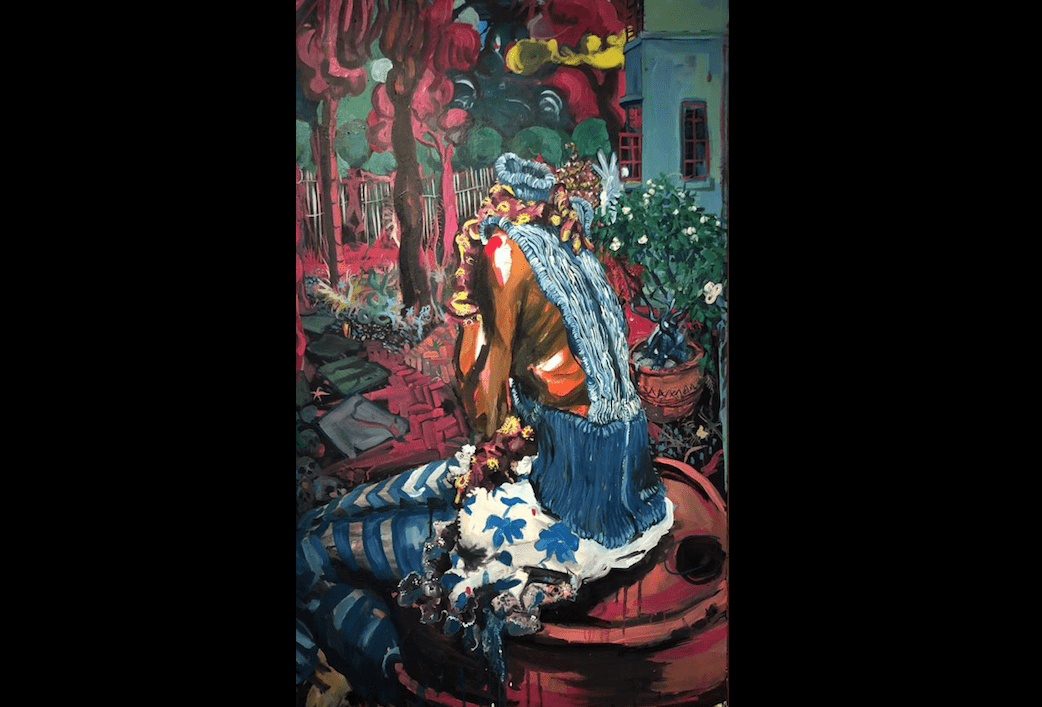Epheas Maposa’s artwork is driven by the words, fears, and expectations of his community. Yet the young artist paints a bigger picture: a hybrid space between Europe and Africa where techniques overlap and perspectives merge. He explores his ideas and techniques as a member of the Zimbabwean artist collective Village Unhu, and is currently showing his work at 31 project in Paris.

Epheas Maposa, 2019, Therapy of the old maid, oil on canvas , 130 x 81 cm– Copyright 31 project/ Village Unhu
Contemporary And: You are a self-taught artist. What has driven you to create your work and your own visual language?
Epheas Maposa: When I was five, and growing up in Harare in 1999, I would pick up my colored pencils not simply because I felt an urge to scribble on paper. It was an intimate matter between me and the white page, an urge to release the recurring images in my brain and those constructed and generated by the conversations of people and nature surrounding me in Harare. Unleashing these imaginings was like ascending to the outer rim of any given storyline. This process still gives me a full sense of my awareness. The energetic sources of a community’s words, fears, and expectations – political or natural – works as a steering wheel that constantly stirs the thrill of revealing and resolving on the surface of my canvas.
C&: You have also talked about your fascination with hybrid lives.
EM: My technique has incorporated the notion of hybridity by combining dual cultures and the painting traditions of European and African movements. My paintings bridge a visual gap by striving for shifts in traditions. In my work the comprehension of figures is hybrid, a combination of symbolisms.
C&: Do you also experiment with other techniques or mediums?
EM: As a young artist, drawing has been the outer membrane for me, hosting within it infinite idealistic possibilities. Although painting is my main practice, I’m still very eager to express my ideas in a variety of practices and mediums. I tend to experiment a lot in order to understand the processes of adding and subtracting, discovering the similarities and uniqueness of different techniques. Experiments usually resolve in ideas and technical principles which can be applied in various mediums. It works as a cycle in motion: Any approach on the canvas gives a platform to viewing one world while being in another.

Epheas Maposa, 2018, Mummified generation 1, oil on canvas , 49 x 64 cm– Copyright 31 project/ Village Unhu
C&: Some years ago Misheck Masamvu and Georgina Maxim invited you to be part of the artistic collective Village Unhu. How has it influenced you and your work?
EM: Joining the Village Unhu collective in 2013 presented the opportunity to grow as a part of an interactive artists’ society. I have grown both intellectually and practically by practicing the fundamentals of growth through observation, research, and interaction. My mentors Misheck Masamvu and Georgina Maxim have set up a mobile platform for self-discovery. In 2014, at the age of nineteen, I had my first local solo exhibition with Village Unhu, at Alliance Française theater in Harare. With the village’s support I became one of the youngest artists to achieve this in the local industry. Over the years being mentored by Misheck has developed me and my perspectives of art and its practice. My confidence in my intuitive perception is still growing and manifesting itself as I work constantly in the studio to discover and paint.
C&: What is the context in which you create your work?
EM: The Southern African art scene, mainly Zimbabwe, has maneuvered its way to becoming one of the most recognized regions on the continent, standing for an incalculable freedom of expression.
The upcoming generation, my generation, is still very eager to achieve a new identity. Delivering resolved and fresh visual works as a sort of reservoir, despite the economic situation and outbreaks of political drama, we have discovered a greater purpose. Working in the manner of recycling materials, for instance. For my generation, the glass is half full.
The group show “We are here pamasonga” at 31 project in Paris shows the work of Village Unhu members Misheck Masamvu, Evans Tinashe Mutenga and Epheas Maposa until 20 October 2019.
Epheas Maposa was born in Zimbabwe in 1994. He lives and works in Harare. The body and the narrative are at the heart of Epheas Maposa’s work: bodies that are half human, half animal, with very marked lines, evolving in surrealist and baroque worlds. Each work delivers a narrative on the thread, mixing in an assumed dreamlike vein, drawn details and colourist motifs. A prolific narrator, he uses the distortion of bodies and spaces to create disillusioned tales that testify to the breakdown of Zimbabwe’s social and political structure.
Interview by Theresa Sigmund.
More Editorial